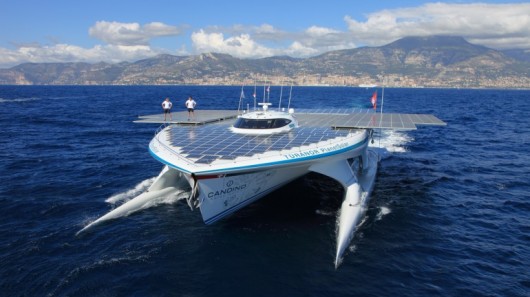World's largest solar-powered boat returns to the oceans in the name of science
April 5, 2013

The MS Tūranor PlanetSolar embarking on its circumnavigation of the globe in 2010 (Photo: PlanetSolar)
The MS Tūranor PlanetSolar, the world's largest solar-powered boat, took to the seas once more on Thursday this time, in the name of science. Equipped with unique instruments, the Tūranor will carry a team of scientists who will monitor the air and water of the Atlantic Ocean's Gulf Stream, a current which influences the climates of North America's east coast and Europe's west. The goal is to gain understanding of the processes which regulate climate.
Circling the North Atlantic
The Tūranor has set out from La Ciocat, France, on a four-month expedition that will encircle the North Atlantic. The vessel's instruments will undergo testing as the boat makes its way out of the Mediterranean. The hard graft, so far as the science is concerned, will not begin until it reaches Miami, Florida, at the south-western tip of the Gulf Stream.
From there, physicists, biologists and climatologists from the University of Geneva, led by Professor Martin Beniston, director of the Institute of Environmental Sciences at the university, will begin continuous monitoring of the air and water in a project dubbed PlanetSolar DeepWater. This is where the Tūranor will come into its own. Being powered solely by photovoltaics, the catamaran has no emissions which could otherwise influence sensitive instruments and the data they collect.
From May, the Tūranor will bunny hop along North America's east coast, calling at New York, Boston and St. John's before striking out for Europe. There the Tūranor will stop at the Icelandic capital, Reykjavķk, ahead of the final leg to Bergen, Norway, where the boat is due some time in August. The 8,000-km (5,000-mile) route follows the main arc of the Gulf Stream across the Atlantic.
For science
"A continuous series of physical and biological measurements will be taken in the water and air to study the key parameters of climate regulation, specifically atmospheric aerosols and phytoplankton," Professor Beniston explained in a press release.
Among the instruments aboard is the University of Geneva's Biobox, claimed to be the only device capable of laser-analysis of aerosols. The device was created with the intention of real-time identification and monitoring of airborne particles such as pollens and spores, with a view to warning the people nearby who may be allergic, and will be used to monitor such particles at sea.
The team of scientists will also monitor ocean phenomena such as eddies and whirlpools which, in the right environment, help to power the so-called ocean conveyor belt that drives circulation in the oceans.
A lucky escape?
It's down to a chance meeting between Professor Martin Beniston and the then crew of the Tūranor, at the end of an epic 19-month circumnavigation of the Earth, that the DeepWater project has come about, granting the catamaran a "second life." Let's hear it for chance encounters, then. The Tūranor deserves to go on being useful.
Sources: PlanetSolar (PDF) and University of Geneva via Wired
Copyright © gizmag 2003 - 2013 To subscribe or visit go to: http://www.gizmag.com
http://www.gizmag.com/turanor-planetsolar-atlantic-science/26946